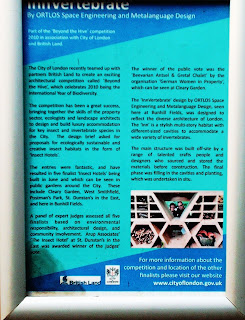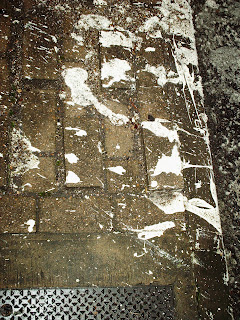FRP Hornbeam's Insect Hotel
It is a long way to travel, from Bunhill Fields to Walthamstow, when being a creature much more small than great. Field Study's Man in E17, in the guise of a tick, failed miserably to latch on to any sanguineous psycho-geographers in the course of his journey. Add to this problem of scale the evolutionary problem of having acquired six more legs with which I scurried in a ridiculous fashion. 8 is just too many. With the blood of ancestral poets long gone I faced a crisis which required seizing a shape shifting opportunity. In the supernatural twilight hanging over Walthamstow Marshes I became with the barely audible (to human ears) proclamation, "I am become Fungus Gnat!" In this form I drifted on the haunted breezes of the marshes and so made my progress a little more effortlessly towards home.
Having stayed in the grand habitation which was 'InnVertebrate' I found myself at another
insect hotel in the borderlands of E17. This hospitality was of a much more thrifty character although I confess to having some doubts about the place. There was a curious and disturbing resonance which I struggled to put one of my six legs on until the screeching brakes of a bus propelled me into the shower scene of Psycho and
Bates Motel where Janet Leigh as Marion Crane met a grisly end.
Bernard Hermann's stabbing sound effects were created by stabbing a melon (you know).
Vacancies
It being Saturday morning, all this paranoia, psycho association and macabre musing was swept away by the conviviality of Organiclea's wholesome, local and organic produce stall.
Organiclea Stall, Bakers Avenue E17 - Saturdays, 10am - 3.30pm.
Is this serendipity? How was it I chose the form of a fungus gnat in my journey of tiny significance? Field Study's Man in E17 is reading, The Stream, by Brian Clarke. In this story, it is the law of continuing that decrees provenance. And so by the law of continuing Field Study's Man in E17, intrepid
fungus gnat extraordinaire, was greeted by a sight of humongous sustenance - thanks to Ru K, parasol mushrooms foraged in the Broxbourne area. Oh great law of continuing, you gave me food and shelter from the blazing November sun.
Field Study's Man in E17 being enticed by a
parasol mushroom.
As I hovered about Roger, preparing to plunge into his parasol, I was distracted by the noise of heated debate - the cladistical ructions of a Springtail or
Collembola conference taking place in the Bakers Avenue Bug Motel. The parsimonious debate concerned the classification of their species. Some of the springtails asserted they are insects while others something else, more ambiguous, more 'inter-cultural'. Cladistical purists were having none of this identity politics. Central to the ruction is the issue of mouth parts. Insects have external mouth parts while Collembola have internal mouth parts. Quips about insects never being able to keep their mouths shut murmured in and out of the assorted shafts of bics and biros. Sensing this dispute might escalate I adopted the role of mediator - peace maker. We are all
mycophyles and here is a stall of earthy mycogastronomic delight. Let us engage our mouth parts in the noble art of eating.
As we sat down to gobble on our dish of fried parasol mushroom seasoned with coarse ground pepper the parsimony abated and we began to tell the tales of our ancestry in a quest for a universal origin. I scratched out a cladogram in the mud. Here is a diligent student's diagram of my 'tree'.
As I waxed lyrical on the ancestry of Field Study's Mandibles in E17 there was a decidedly irritated and objecting voice calling out, "Spurious, totally spurious psycho-cladogrammatics!"

















































